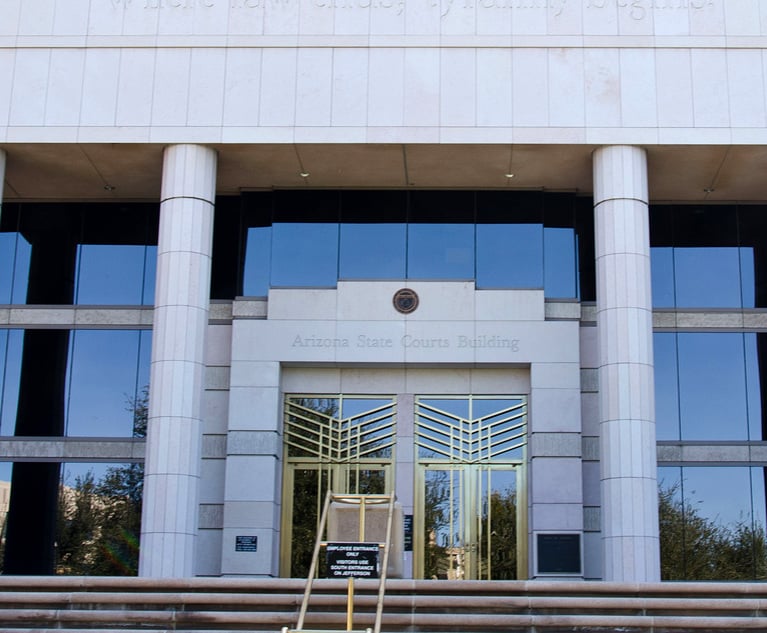Litigation support and e-discovery: Entering the spotlight
During the past six months we have met with mor than 100 law firms in the UK to discuss their current approach to e-discovery, their anticipated requirements in the context of the current economic climate and their expectation of increasing levels of disputes. We have concluded that the use of e-discovery technology for UK law has reached a tipping point whereby it will become normal practice to use e-discovery technology in relation to even relatively low value disputes.
May 06, 2009 at 10:04 PM
8 minute read
Clients and firms are looking for ways to save money and as a result, the use of e-discovery technology is coming to the forefront. James Moeskops explains
During the past six months we have met with mor than 100 law firms in the UK to discuss their current approach to e-discovery, their anticipated requirements in the context of the current economic climate and their expectation of increasing levels of disputes. We have concluded that the use of e-discovery technology for UK law has reached a tipping point whereby it will become normal practice to use e-discovery technology in relation to even relatively low value disputes.
The trend to e-discovery
There are four key factors driving this trend – cost pressure from clients; increasing maturation of e-discovery technology; a judiciary increasingly aware of e-discovery and prepared to address costs; and competitive pressure as more innovative law firms leverage the technology for a competitive advantage.
It is worth noting that one of the factors not mentioned is the ever-increasing volume of electronic documents. This is not an emerging factor, as virtually everyone has been using email as the primary form of communication for at least the past decade. As such, it is a truism that documents that may need to be reviewed and potentially disclosed in most disputes will have originated in electronic form. Previously, firms seeking to drive sales in the e-discovery sector adopted scare tactics, warning of an imminent tsunami of electronic documents and the potential risks and liabilities associated with a lack of preparation. The reality, however, is that, unlike the US legal system, the UK system's concept of proportionality largely eliminates the tactic of swamping opponents with huge volumes of electronic documents.
Blast from the past
In early 2008 we met with a wide cross-section of law firms in the UK and were astounded to find that for most disputes, the approach to review and disclosure of electronic documents was to open them one at a time, print the relevant ones, manually sort these into chronological order and then go about the document review, disclosure and trial preparation process entirely in paper form. At the time, we coined the term 'justifiable inefficiency' to describe the manual and inherently inefficient approach adopted by many law firms. Given that most firms generally still bill on an hourly basis, inefficiency equates to cost for the client, but also inevitably fees to the law firm.
Prior to the global financial crisis there may not have been the commercial impetus for law firms to seek ways to be more efficient and thereby reduce the costs associated with litigation. In the current climate, while most law firms are seeing a jump in the volume of enquiries and potential new matters, corporate clients do not have the appetite or, indeed, funds to engage in potentially protracted high stakes litigation. Instead, we are hearing that law firm clients are focused on minimising costs, buying time or eliminating uncertainty even to the extent of settling on less attractive terms.
More and more firms are considering alternative fee structures and approaches to fund litigation. These include fixed or capped fees, often under the banner 'value-based' fees, conditional fee arrangements, after-the-event insurance and third party litigation funding. The rationale for such approaches is to align the interests of the law firm with the client, reduce uncertainty or minimise cost. In reality, client pressure to reduce cost represents a major threat to the revenue base of law firms that do not otherwise identify ways to offer clients more cost-effective dispute resolution services. Innovative law firms are embracing the opportunity to increase margins and attract more business by proving to existing and potential clients that they can offer equivalent or superior dispute resolution services at lower cost.
Evolution of e-discovery
The second factor driving the widespread use of e-discovery technology is the emergence of a range of established specialists offering the technology and expertise to meet the diverse e-discovery requirements of law firms and their clients. The evolution of e-discovery technology has been accelerated by the flurry of regulatory and investigation activity in recent years from the likes of the Securities and Exchange Commission, Office of Fair Trading, Serious Fraud Office and European Commission. Over the past decade there has been an e-discovery technology 'arms race', leading to rapid advances in speed, scale, security and usability of software. Features incorporated into the latest e-discovery software include de-duplication, email thread analysis, sophisticated search and visualisation of communication threads. These have been shown to reduce the time required by lawyers, paralegals or other support staff to filter, search, review, categorise, list, disclose and prepare documents for a hearing or trial.
Providers of e-discovery services range from niche forensic technology and one-stop litigation support firms through to global accounting, consultancy and technology firms. Intense competition and improvements in technology have seen prices for the core elements of discovery services plummet. To illustrate how far e-discovery costs have fallen, we estimate that a large e-discovery project undertaken five years ago which took upwards of six months and cost more than £500,000 would today be completed within days and cost less than £10,000.
 A key benefit of the technological improvements, reduced prices and increased speed is that the latest e-discovery technology is available to any law firm of any size on any matter and at a price that will be proportionate to the claim. For instance, from as little as £500 it is possible to have 10,000 emails and their associated attachments de-duplicated and presented in an online hosted database. The database can then be accessed by many lawyers concurrently to sort, search, categorise and efficiently perform all of the actions required from early case assessment through to trial preparation. Law firm clients are finding it increasingly easy to justify to their clients the use of e-discovery technology and by engaging third-party consultants, the law firm simply passes such costs on as a disbursement, avoiding the need to justify and allocate what would otherwise be an internal overhead.
A key benefit of the technological improvements, reduced prices and increased speed is that the latest e-discovery technology is available to any law firm of any size on any matter and at a price that will be proportionate to the claim. For instance, from as little as £500 it is possible to have 10,000 emails and their associated attachments de-duplicated and presented in an online hosted database. The database can then be accessed by many lawyers concurrently to sort, search, categorise and efficiently perform all of the actions required from early case assessment through to trial preparation. Law firm clients are finding it increasingly easy to justify to their clients the use of e-discovery technology and by engaging third-party consultants, the law firm simply passes such costs on as a disbursement, avoiding the need to justify and allocate what would otherwise be an internal overhead.
Backing technology
Another aspect reflecting the coming of age of the market for e-discovery services in the UK is that the judiciary are becoming increasingly informed as to the costs and benefits of e-discovery. Last year saw the first three important decisions by the English Courts involving the approach to discovery and costs associated with document disclosure (Digicel v Cable & Wireless, Abela v Hammond Suddards and Hedrich v Standard Bank).
Other judicial initiatives in progress include the drafting of a technology questionnaire to address the potential sources and nature of electronic documents when applying Part 2A.2 of the Practice Direction to Part 31; a new Practice Direction under Part 31; and Lord Justice Jackson's litigation costs review, which had input from a number of leading e-discovery commentators and consultants. There is also a pilot project running in the Commercial Court that draws upon the recommendations contained in the Aikens report on long trials in the Commercial Court.
Only a matter of time
Although it is still early days and there has not yet been an English case where the decision turned on issues of disclosure or e-discovery, the judiciary have shown an increasing willingness to challenge the current approach and the resulting costs incurred in litigation. Given all other factors, it may only be a matter of time before a case fails on account of the approach to disclosure or that judges may begin to rule that the costs of disclosure on particular matters were in fact disproportionate, resulting in an adverse costs determination. The Civil Procedure Rules (CPR) already oblige the court to consider pact of technology in relation to the overriding objective and contains the power to strike out a claim or a defence in the event of failure to comply with the CPR. Were this to occur, the reputational impact on the law firm(s) involved could be huge and would have a domino effect on any firms found to have incurred disproportionate costs by virtue of inefficiency or inappropriate approach to the disclosure.
The final and arguably most important factor tipping law firms towards widespread use of e-discovery technology is competition. There are more instances of law firm clients gaining competitive advantage in commercial disputes over the past six months than at any time over the past nine years.
Whether the UK has reached a tipping point in the use of e-discovery technology for the majority of disputes may be debatable; however, in the current economic climate and the coming together of the significant factors mentioned above, litigation lawyers must have a good understanding of e-discovery techniques and be familiar with the services of specialist consultants who can assist them.
James Moeskops is managing director of Millnet's legal services.
This content has been archived. It is available through our partners, LexisNexis® and Bloomberg Law.
To view this content, please continue to their sites.
Not a Lexis Subscriber?
Subscribe Now
Not a Bloomberg Law Subscriber?
Subscribe Now
NOT FOR REPRINT
© 2025 ALM Global, LLC, All Rights Reserved. Request academic re-use from www.copyright.com. All other uses, submit a request to [email protected]. For more information visit Asset & Logo Licensing.
You Might Like
View All

Some Elite Law Firms Are Growing Equity Partner Ranks Faster Than Others
4 minute read
KPMG's Bid To Practice Law in US On Hold As Arizona Court Exercises Caution
Trending Stories
- 1Public Notices/Calendars
- 2Wednesday Newspaper
- 3Decision of the Day: Qui Tam Relators Do Not Plausibly Claim Firm Avoided Tax Obligations Through Visa Applications, Circuit Finds
- 4Judicial Ethics Opinion 24-116
- 5Big Law Firms Sheppard Mullin, Morgan Lewis and Baker Botts Add Partners in Houston
Who Got The Work
J. Brugh Lower of Gibbons has entered an appearance for industrial equipment supplier Devco Corporation in a pending trademark infringement lawsuit. The suit, accusing the defendant of selling knock-off Graco products, was filed Dec. 18 in New Jersey District Court by Rivkin Radler on behalf of Graco Inc. and Graco Minnesota. The case, assigned to U.S. District Judge Zahid N. Quraishi, is 3:24-cv-11294, Graco Inc. et al v. Devco Corporation.
Who Got The Work
Rebecca Maller-Stein and Kent A. Yalowitz of Arnold & Porter Kaye Scholer have entered their appearances for Hanaco Venture Capital and its executives, Lior Prosor and David Frankel, in a pending securities lawsuit. The action, filed on Dec. 24 in New York Southern District Court by Zell, Aron & Co. on behalf of Goldeneye Advisors, accuses the defendants of negligently and fraudulently managing the plaintiff's $1 million investment. The case, assigned to U.S. District Judge Vernon S. Broderick, is 1:24-cv-09918, Goldeneye Advisors, LLC v. Hanaco Venture Capital, Ltd. et al.
Who Got The Work
Attorneys from A&O Shearman has stepped in as defense counsel for Toronto-Dominion Bank and other defendants in a pending securities class action. The suit, filed Dec. 11 in New York Southern District Court by Bleichmar Fonti & Auld, accuses the defendants of concealing the bank's 'pervasive' deficiencies in regards to its compliance with the Bank Secrecy Act and the quality of its anti-money laundering controls. The case, assigned to U.S. District Judge Arun Subramanian, is 1:24-cv-09445, Gonzalez v. The Toronto-Dominion Bank et al.
Who Got The Work
Crown Castle International, a Pennsylvania company providing shared communications infrastructure, has turned to Luke D. Wolf of Gordon Rees Scully Mansukhani to fend off a pending breach-of-contract lawsuit. The court action, filed Nov. 25 in Michigan Eastern District Court by Hooper Hathaway PC on behalf of The Town Residences LLC, accuses Crown Castle of failing to transfer approximately $30,000 in utility payments from T-Mobile in breach of a roof-top lease and assignment agreement. The case, assigned to U.S. District Judge Susan K. Declercq, is 2:24-cv-13131, The Town Residences LLC v. T-Mobile US, Inc. et al.
Who Got The Work
Wilfred P. Coronato and Daniel M. Schwartz of McCarter & English have stepped in as defense counsel to Electrolux Home Products Inc. in a pending product liability lawsuit. The court action, filed Nov. 26 in New York Eastern District Court by Poulos Lopiccolo PC and Nagel Rice LLP on behalf of David Stern, alleges that the defendant's refrigerators’ drawers and shelving repeatedly break and fall apart within months after purchase. The case, assigned to U.S. District Judge Joan M. Azrack, is 2:24-cv-08204, Stern v. Electrolux Home Products, Inc.
Featured Firms
Law Offices of Gary Martin Hays & Associates, P.C.
(470) 294-1674
Law Offices of Mark E. Salomone
(857) 444-6468
Smith & Hassler
(713) 739-1250









